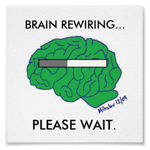Monday, 7 November 2016
Norman Doidge and cerebral plasticity

This week, I want to recommend a Brain Science Podcast featuring Dr. Norman Doidge, first posted online in February 2015. This podcast was in a sense a sequel to one devoted to Doidge’s book The Brain That Changes Itself (links to both podcasts are provided below). Both of these programs discuss a fundamental characteristic of the human brain: its great plasticity, even in adults—in other words, the fact that the brain’s neural circuits reorganize themselves constantly throughout our lifetimes.
In the second of these podcasts, Dr. Doidge and host Dr. Ginger Campbell discuss the implications of the brain’s plasticity for rehabilitation following brain injuries. Although researchers have amply demonstrated this plasticity, clinicians unfortunately still tend to minimize its importance, possibly because the treatments based on it, such as those proposed by Dr. Doidge, require patients to participate actively, instead of just taking pills.
In the same conversation, Dr. Doidge also confirms two ideas that are making increasing inroads in the scientific community. The first is that in their discussions of human cognition, some scientists may be placing too much emphasis on the role of the cerebral cortex. Other scientists have made similar statements—for example, Merker in his writings on consciousness and Panksepp in his writings on emotions. The example that Doidge cites is the case of sub-cortical injuries for which the cortex may compensate in some way, but at the cost of experiencing a “work overload” that results in other problems. These problems are then mistakenly attributed to the cortex, because it is so important in the human brain (accounting for 80% of its mass).
The second idea that Doidge underscores is one that has been discussed frequently in this blog: that we are more than just our brain. But in no way is Doidge arguing for a return to some form of dualism He is simply acknowledging an undeniable fact: animals’ nervous systems have always evolved within their bodies, which are in turn situated in their environments. And it is this entire nested system, this embodied cognition, that lets individuals “think in the world”, or rather “think their world into being” the product of the traces stored in their nervous systems throughout their lives thanks to the plasticity of their neural connections.
![]() Les Étonnants pouvoirs de transformation du cerveau
Les Étonnants pouvoirs de transformation du cerveau
![]() 9th Annual Review of Neuroscience (BSP 125)
9th Annual Review of Neuroscience (BSP 125)
![]() BSP 116: Norman Doidge on Brain Plasticity
BSP 116: Norman Doidge on Brain Plasticity
![]() Neuroplasticity with Dr. Norman Doidge (BSP 26)
Neuroplasticity with Dr. Norman Doidge (BSP 26)
Memory and the Brain | No comments







